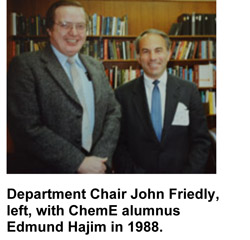Celebrating 100 years of UR chemical engineering: The Energy Crisis
The oil crisis of 1979, triggered by the Iranian Revolution, caused long lines to form at American gasoline pumps, just as they had six years earlier.

At the same time, enrollment in chemical engineering at the UR – and nationwide -- was approaching an all-time high, fueled in part by the “frantic hiring practices by companies in the energy field,” John Friedly writes in his 75th anniversary book about ChemE.
“Several recruiters from the major companies came to the Department with check in hand, hoping to gain an advantage. It was relatively easy for undergraduates to obtain multiple job offers, and select the best opportunity.”
When Friedly took over as chair in 1981, enrollment was at an all-time high in UR chemical engineering. Overworked faculty struggled to keep up with classes so large that close interaction with students could not be maintained.
This did not last long. “One of Ronald Reagan’s first acts in the White House was to cancel the synthetic fuels program,” Friedly wrote. “Oil companies that had been using excess profits from rapidly inflating oil prices, coupled with federal funding for synthetic fuels, to sop up all engineers in sight immediately saw the danger signal. Hiring was abruptly halted.”
The number of chemical engineering degrees awarded at UR dropped from 57 in 1983 to 20 in 1986, then stabilized.
The Department concentrated primarily on the graduate program in the latter half of the 1980s, Friedly wrote. By September 1987 the full-time graduate student population had risen to 54, believed to be the largest it had ever been.
